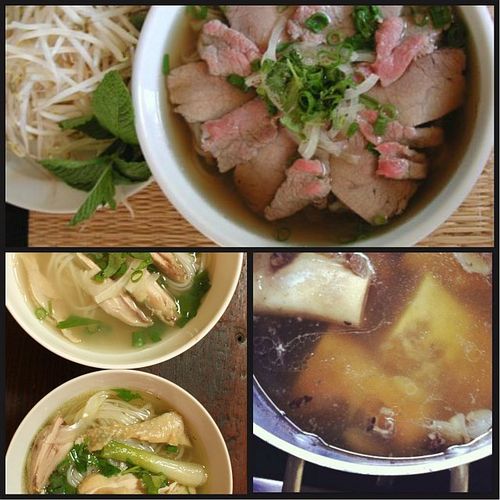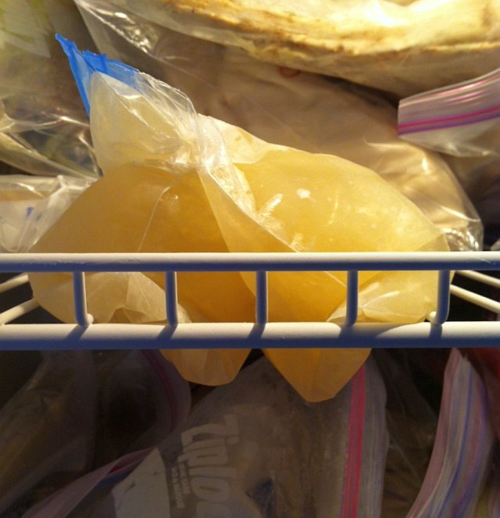I was on the road this week when I received this email from Mike:
I'm just finishing up your beef stock recipe -- it took a little while longer than I expected because my butcher gave me almost 14 lbs of great beef bones! I will be trying the Pho tonight!
I just got back from a two week vacation in Vietnam. I had pho almost every morning for breakfast and a few times for lunch. I just love it!
I do have a question: I live by myself most of the time, so I can't eat 8 bowls all at once by myself. Do you have any advice or hints about how to store things so I can pull the stock out of the freezer and just whip up a bowl whenever I want? I'm going to try saving the cooked meat in small batches. Same with freezing small chunks of the sirloin steak I bought.
You have a terrific website and I'm recommending it to all my friends. I'll be getting your cookbook, too! I got your dumplings cookbook last year and my daughter and I enjoyed great success with it.
What a flattering and great message to get. It’s so great to travel, eat something new and exciting, then return home to replicate it.
But wow, fourteen pounds of bones meant that Mike had enough pho for a reasonably-sized Viet extended family or a small pop-up lunch for 16 people. Since those situations didn’t apply to him, and he wasn’t about to call his friends and neighbors over to share the wealth, he was on to the obvious answer: Freeze that pho!
You know I love to freeze food to create a personal food bank of sorts. Yes, sometimes I forget what’s in my freezer but with regard to pho, I never forget that it’s in the freezer. I’ve spent too much time on it and it’s a precious commodity. Here’s what I do with a big batch of beef or chicken pho:
BROTH: Cool the broth and keep some of the fat. You can skim some of the fat off but save about 15 to 20 percent because it adds to a round mouthfeel and rich flavor. That fat is great when the broth is fresh as well as thawed. It will look gross so look beyond it to your future bowls of pho.
Fill quart-size (liter) plastic containers – for example, recycled yogurt containers – with broth to come to about 1 inch of the rim. A quart-size amount is about 2 servings. Once the broth freezes, it expands so don’t fill the container to the rim or the lid will pop off. Close it well (give it a burp) and slide it into the freezer.
If you don’t have plastic containers, use plastic zip-top bags that are thick enough for the freezer. Fill gallon-size bags partway with the broth and seal well. Lay the bag on a baking sheet or tray to freeze it flat. This is what happens when I lazily put my broth into the freezer. It’s not easy to pry the bags from the freezer shelf. They are currently stuck:
MEAT: I freeze the cooked beef and any tendonous bits scraped from the bones in quart-size zip-top plastic bags. That way, they’re portioned off for the future. The raw beef doesn’t get frozen because frozen steak can lose too much moisture during thawing and not be at its peak; use up the raw beef in a stir-fry. In advance of using the thawed pho broth, I buy a new little piece of steak from my butcher.
I don’t freeze the cooked chicken because I don’t like thawed cooked chicken. It just doesn’t seem to revive well, tasting bland. I’d rather poach some fresh chicken in the thawed broth, which will add to the flavor anyway.
With the broth and meat frozen, you’re ready for pho. (I’ve never frozen rice noodles. Have you?) I don’t keep pho broth or the cooked beef frozen for longer than 3 months. They can go flat in flavor.
TO USE: Partially thaw the pho broth or just loosen it from the container (or bag) under hot running water. Then dump the frozen block of pho broth into a saucepan. Ideally, the beef has been totally thawed (pull it out of the freezer an hour or so beforehand or use the microwave oven). Add a good splash of water to the broth and bring to a simmer. Put the cooked beef in there to refresh it. Or, just slice the meat super thin to allow the boiling broth to warm it well later on.
With the chicken pho broth, add a half cup of water and then poach a boneless chicken thigh or breast in the broth. For a 5-ounce (150 gram) piece, cook it for about 10 minutes after the broth returns to a simmer. Knick with a knife to check doneness.
Sometimes I add one or two smashed slice of ginger to the broth to revive it. The rest of the pho assembly is the same. Remember to taste and adjust the flavor of the broth before ladling it into your bowls.
[4/7/14] P.S.... Phi from Vietnam asked if the aroma degrades from freezing. Yes it can, I responded to him, so my usual fix is the ginger. You can add a bit of the spices that you originally used to make the broth but that seems fussy. If you go that route, I wouldn't keep the spices in the thawed/reheating broth for too long, just till you smell the goodness you seek. Using good beef marrow (leg bones) helps set the foundation.
Got any frozen pho tips or story to share? Or make-ahead pho questions?
Related posts:



















Steve says
I usually freeze my stock in quart freezer bags. I put about 500mL per bag, as it's a handy portion for cooking dinner. I use a 9x9 cake pan or a bread pan to help the bags hold their shape while they freeze and take them out of the pan after freezing.
[email protected] says
I freeze my rice noodles all the time. I think they taste just fine. They just have to be mostly thawed. If they are frozen and go right into boiling water, they break into a million pieces. Also, Iwhen I've not been able to thaw the whole container of broth and just eat the thawed out portion, it was bland. You have to reheat the whole container. The seasonings all sink to the bottom of the container.
Andrea Nguyen says
Very smart, Steve!
Andrea Nguyen says
Got it. I was wondering about the noodles breaking. I wonder if they'd be easier to thaw in the microwave oven -- to avoid breaking that is.
It is true with thawing and using the entire container of broth. Going smaller is better with the portions then.
Dennis M Reed says
regarding the noodles, keep dry noodles on hand and prepare them while defrosting the broth and meat.
Yen says
hi - I have froze fresh rice noodles before. I just put the frozen noodles in a bowl and fill it with cold to slightly lukewarm water and let it soak for about 10 to 30 mins or until the noodles are loose (I will replace the water in the bowl at least once during this timeframe). Then drain the bowl and cook as you normally would. The noodles doesn't break and still tastes great.
Andrea Nguyen says
Yup, right on.
Andrea Nguyen says
I assume that you froze the fresh banh pho rice noodles in their vacuum-sealed package. That's what I was thinking. Very very smart of you to keep a frozen supply. Thank you for sharing the tip!!!
Yen says
Andrea, oops I left that part out. Thanks for clarifying for me! But yes in their vacuum sealed bag.
Amy Paice says
try a hair dryer to get the misshapen bag out of freezer
Andrea Nguyen says
Love that idea, Amy. Thank you!!!!
Teresa says
Hi Andrea, I think pho is the best food on earth, could eat it every day! my husband is Vietnamese and I am going to cook pho for us. i was wondering if i can ask you this question here. in one of your older posts about pho you mentioned about avoiding neck bones, why is that? I understand the importance of knuckle bones with marrow but why neck bones are not good for pho? could i just mix them? 4lb knuckle and 1lb neck bones, for instance? will neck bones spoil my broth in any way?
Thank you in advance for your expert advice 🙂